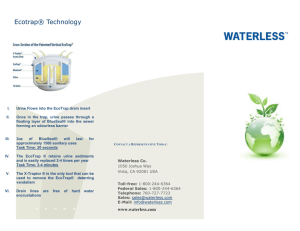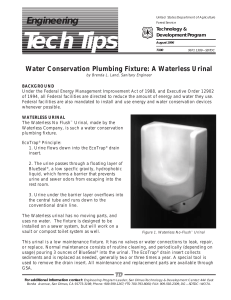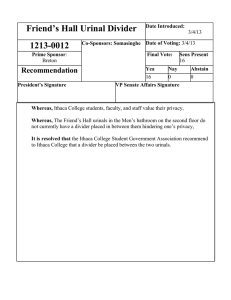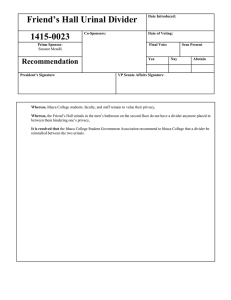Waterless Urinals - MaP Toilet Testing
advertisement
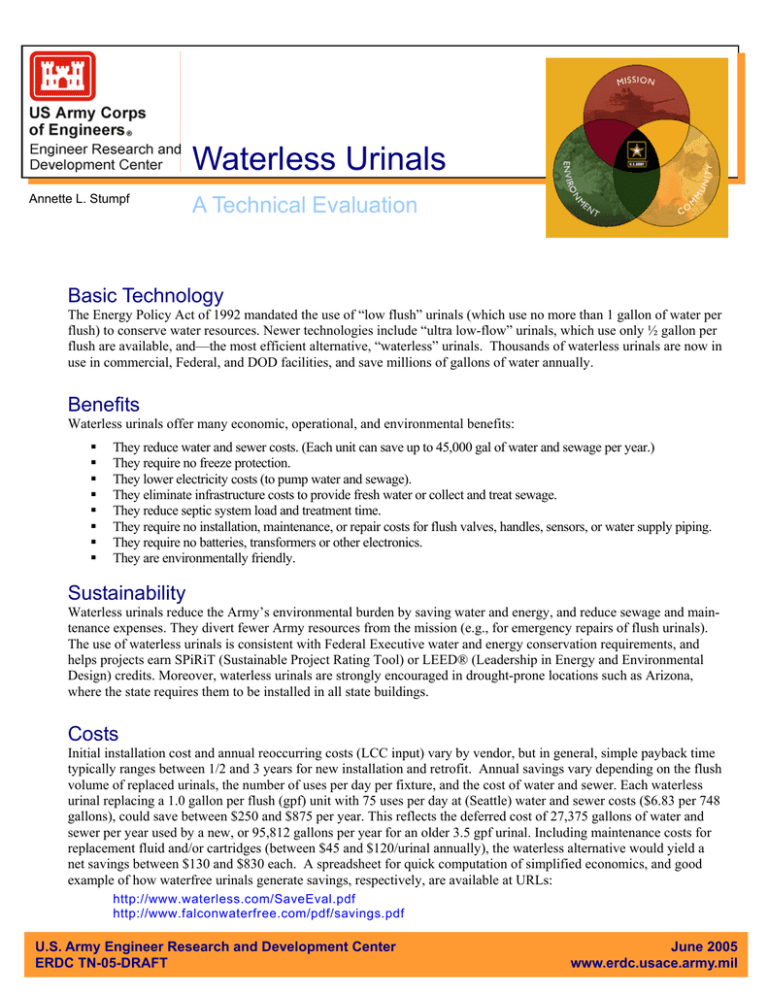
Waterless Urinals Annette L. Stumpf A Technical Evaluation Basic Technology The Energy Policy Act of 1992 mandated the use of “low flush” urinals (which use no more than 1 gallon of water per flush) to conserve water resources. Newer technologies include “ultra low-flow” urinals, which use only ½ gallon per flush are available, and—the most efficient alternative, “waterless” urinals. Thousands of waterless urinals are now in use in commercial, Federal, and DOD facilities, and save millions of gallons of water annually. Benefits Waterless urinals offer many economic, operational, and environmental benefits: They reduce water and sewer costs. (Each unit can save up to 45,000 gal of water and sewage per year.) They require no freeze protection. They lower electricity costs (to pump water and sewage). They eliminate infrastructure costs to provide fresh water or collect and treat sewage. They reduce septic system load and treatment time. They require no installation, maintenance, or repair costs for flush valves, handles, sensors, or water supply piping. They require no batteries, transformers or other electronics. They are environmentally friendly. Sustainability Waterless urinals reduce the Army’s environmental burden by saving water and energy, and reduce sewage and maintenance expenses. They divert fewer Army resources from the mission (e.g., for emergency repairs of flush urinals). The use of waterless urinals is consistent with Federal Executive water and energy conservation requirements, and helps projects earn SPiRiT (Sustainable Project Rating Tool) or LEED® (Leadership in Energy and Environmental Design) credits. Moreover, waterless urinals are strongly encouraged in drought-prone locations such as Arizona, where the state requires them to be installed in all state buildings. Costs Initial installation cost and annual reoccurring costs (LCC input) vary by vendor, but in general, simple payback time typically ranges between 1/2 and 3 years for new installation and retrofit. Annual savings vary depending on the flush volume of replaced urinals, the number of uses per day per fixture, and the cost of water and sewer. Each waterless urinal replacing a 1.0 gallon per flush (gpf) unit with 75 uses per day at (Seattle) water and sewer costs ($6.83 per 748 gallons), could save between $250 and $875 per year. This reflects the deferred cost of 27,375 gallons of water and sewer per year used by a new, or 95,812 gallons per year for an older 3.5 gpf urinal. Including maintenance costs for replacement fluid and/or cartridges (between $45 and $120/urinal annually), the waterless alternative would yield a net savings between $130 and $830 each. A spreadsheet for quick computation of simplified economics, and good example of how waterfree urinals generate savings, respectively, are available at URLs: http://www.waterless.com/SaveEval.pdf http://www.falconwaterfree.com/pdf/savings.pdf U.S. Army Engineer Research and Development Center ERDC TN-05-DRAFT June 2005 www.erdc.usace.army.mil Waterless Urinals ERDC TN-05-DRAFT June 2005 Implementation & Maintenance Most existing wall-mounted fixtures and all new urinals can be replaced with waterless urinals to save the cost of water, sewage treatment and pumping power. Waterless urinals connect to standard 2-in. drain lines and require no water supply line. Waterless urinals available in the United States typically have a replaceable trap and/or liquid sealant which floats on top of the urine to form a barrier to keep sewer vapor from escaping. Other alternatives include the trapless “Airflush” urinal made in Sweden which uses a small exhaust fan to extract odors instead of the replaceable trap and/or sealant, and an Australian idea of simply turning off the water and replacing it with a small block of microbes each week. Successful implementation for new and retrofit applications depends on several factors: Ensure correct drain pipe material and slope. Drain lines must slope at least ¼-in. per foot, and cannot be made of copper pipe, which corrodes. Drain lines must be clean before urinal installation. (Test kits are available to determine if drain pipes are sloped adequately for retrofit.) http://www.falconwaterfree.com/pdf/029-Pitch.pdf Eliminate drain pipe obstructions. Studies into the corrosive effects of urine on drain pipes have proven that encrustation is due more to the mineral content of water than to urine. Several waterless urinal users report that they rout their drain lines annually to keep them clear. Other users have reported no buildup problems. Follow vendor maintenance instructions exactly. Different vendors suggest specific cleaning materials, maintenance procedures, and intervals. Keep a urinal maintenance log. Keep a log be of cartridge replacement dates or trap service dates to guard against premature or too-frequent cartridge replacements or trap servicing. Keep a record of all sealant and cartridge purchases to determine average sealant costs per urinal. Monitor high use facilities during peak usage periods. Waterless urinals have been endorsed or accepted in many parts of the country, but some state and local code agencies may prohibit their use or permit only “test” projects. UFC 3-420-01 permits their use in DoD facilities, which overrides local codes, but educating local code officials on the benefit of waterless urinals may speed their acceptance. Recommendation It is recommended that waterless urinals be considered for new urinal installations and to replace existing urinals that use 1.5–3 gpf if retrofit criteria are met and proper maintenance procedures can be budgeted and assured. Vendor List (Partial) Vendor INTERNET URL Falcon WaterfreeTM urinal http://www.falconwaterfree.com/ http://www.sloanvalve.com/waterfreeindex2.htm http://www.waterless.com http://www.uridan-usa.com http://www.duravit.com http://www.greenspec.co.uk/html/products/airflush.html http://www.ifosanitar.com/ http://www.desert.com.au/html/intro.htm Sloan WaterfreeTM urinal Waterless No-FlushTM urinal Uridan® Non-Water Urinal German-made Dry urinal Airflush (not in US yet) made by Ifo Sanitar AB DesertCube® Waterless Urinal References DoD specifications are contained in the Construction Criteria Base (CCB) available on the Whole Building Design Guide website at: http://www.wbdg.org International Code Council International Plumbing Code – 2003 (ICC IPC) (10-01-2004): UF-15400 Plumbing, General Purpose http://www.ccb.org/docs/UFGS/UF15400.pdf Unified Facilities Guide Specs 25 October 2004: http://www.ccb.org/docs/UFC/3_420_01.pdf “Why Non-Flushing Urinals Fail (And How to Prevent Those Failures),” Environmental Building News, vol. 13, No. 11, Nov. 2004, pp. 4 - 6. http://www.buildinggreen.com/auth/article.cfm?fileName=131104b.xml Army Knowledge Online – Water Conservation Web Site. Additional information on waterless urinals will be available through URL. https://eko.usace.army.mil/cop/water/
